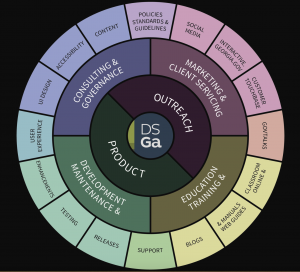As local digital service teams continue cropping up across the country, the focus on technological advancements dominates the narrative. But their duties don’t have to end at website updates and information technology (IT) consultations to get agencies up to date.
At Digital Services Georgia (DSGa), for example, Chief Digital Officer Nikhil Deshpande believes the team’s main responsibility is to create better programs for constituents.
“The soul of digital services is user-centered design,” Deshpande said in an interview with GovLoop. “That’s truly where our value is. Any organization that has a budget can implement any technology. We want to make sure that we are truly designing something for our users.”
Human-centered design dictates everything that DSGa does. Traditional technological improvements are a core part of its function, but improvements are made with the needs of citizens in mind every step of the way.
“The goal is to use the most appropriate technology and information to make every interaction as frictionless, fast and helpful as possible for Georgians,” Deshpande explained.
To do this, Digital Services Georgia relies on data from the public to back up its work. Deshpande provided an example of how the team gathers data to show agencies where changes are needed to improve constituent experience. To test mobile app design, the team not only tracked how users were interacting with the items on their screens, they also tracked facial expressions to gather details about user sentiments.
This tactic provided the team with the data needed to support their reasoning for making certain user-centered changes and convince stakeholders that user-centric design is valuable. If an agency wanted to make an adjustment to its website, but the digital services team had data proving that similar changes displeased Georgians in a previous update, the agency could change course to avoid dissatisfaction.
Another tool Digital Services Georgia uses to gather data on what constituents want is the government website’s search bar. The DSGa team can view the terms that Georgians commonly search for to understand the needs of constituents and the language they use to communicate those needs. From there, they can update resources or add additional resources to solve citizen headaches.
The lesson is, simply, to use the tools already in place to aggregate meaningful constituent data. Surveys and other opportunities for direct feedback serve a purpose, but by learning from the seemingly subconscious actions of constituents, digital services teams can anticipate what citizens need ahead of the curve. Deshpande said that keeping their finger on the pulse of constituents’ need is a crucial part of their jobs.
“Our biggest source of inspiration is speaking with Georgians and understanding what their expectations are,” Deshpande noted. “That is the key to inform us in what we could be doing next.”
DSGa’s Collaboration, Growth and Current Endeavors
Digital Services Georgia also gains insights from collaborations with other states. While each state is geographically different, Deshpande believes that citizens across the country need the same basic things from their state governments. By meeting with other digital services leaders, DSGa is able to implement new, effective models. This helps every state better service their constituents’ digital needs.
Deshpande specifically commended the digital service team in Massachusetts for their partnership and willingness to share information on projects such as fine tuning Georgia’s content management system’s content models.
Because of these collaborations and initiatives, Digital Services Georgia has been recognized for its award-winning leaders and innovative advancements. Deshpande said that while it’s heartwarming to receive recognition for his team’s efforts, their proudest moments are the times when their work makes an impact.
“It’s not so much about what we do or what we accomplish,” he said. “It’s more about the outcome than the output. When we make a certain change or work on a certain project and it actually starts showing a difference and the results start showing in the way that we were expecting them to, those are the moments that we truly benefit, enjoy and celebrate.”

Deshpande shared that for a team to be successful, each member must understand how each other’s roles build towards the final goal. For Digital Services Georgia, he created this chart to illustrate the value each team member adds and how the roles overlap.
That said, before team members dedicated themselves to digital resources, they were simply the go-to for agencies that needed help updating their websites. Getting to where they are today, in terms of proactively working with agencies to anticipate constituents’ needs, required a dedicated staff and approval from higher-ups.
The chief information officer (CIO) liked the idea of building a full digital service team and from there DSGa leaders implemented a grassroots approach to build the team from the ground up. Even with an established team, other government agencies still need to be incentivized to use the digital services them.
“You need some sort of a mandate for other agencies to acknowledge the presence of digital services to be able to integrate them in that planning process,” Deshpande recommended.
Once approval and funding are secure, finding talented team players is the next hurdle. On this, Deshpande’s advice is to network. Digital Services Georgia utilizes its internship program to find and keep skilled employees, but identifying good employees is difficult. Attending conferences, presentations and other professional events to get to know the digital services leaders in the community helps.
The current team at Digital Services Georgia improved the state’s digital publishing platform to increase accessibility, redesigned Georgia’s state website to make it easier for citizens to quickly reference useful information and is now working on rebranding state services to better reflect constituents’ digital dependencies. All of these projects remain focused on putting people first by understanding their wants and needs.
“If people can’t use it, they won’t,” Deshpande said. “They will pick up a phone and call and don’t mind waiting however long it takes for their question to be answered, or they’ll just give up and walk in. We all know no one likes to do it. If we, at the digital level, are able to help them as fast as we can, I think that’s a win-win for everybody.”
Photo Credit: Ken Lund via Flickr





This is an awesome quote: “The soul of digital services is user-centered design,” Deshpande said in an interview with GovLoop.
I agree with Mark! But my favorite personally is: “It’s more about the outcome than the output.” This is just one of those stories of government innovation that makes so much sense, which is awesome. Gutteral reactions and search bars are such great measurements, and happy to hear the focus on UCD.